
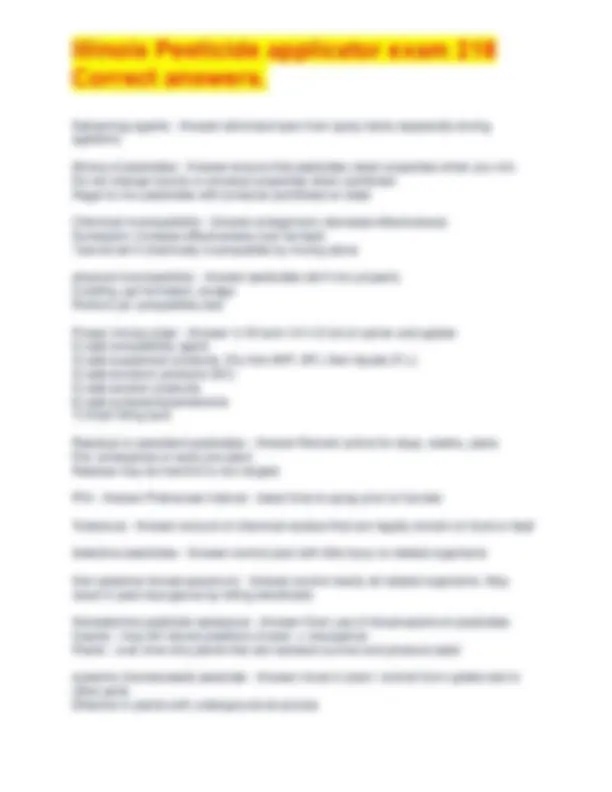
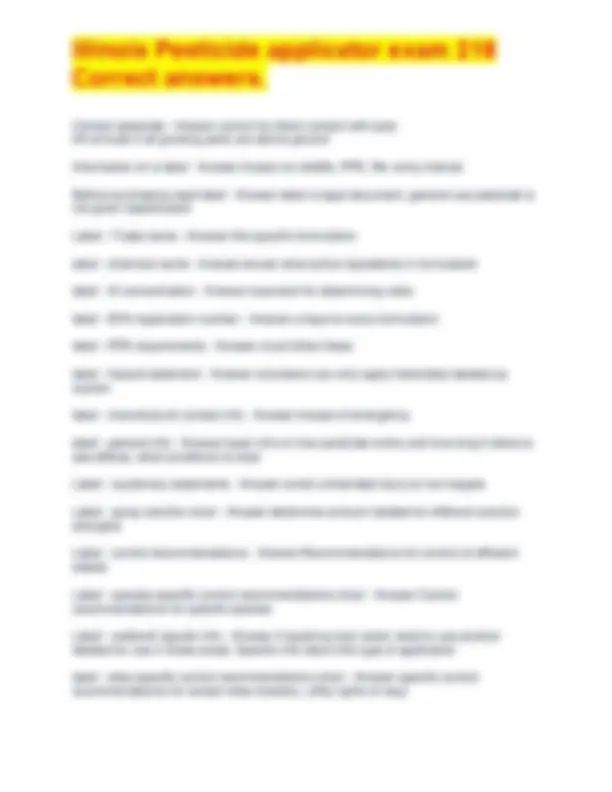
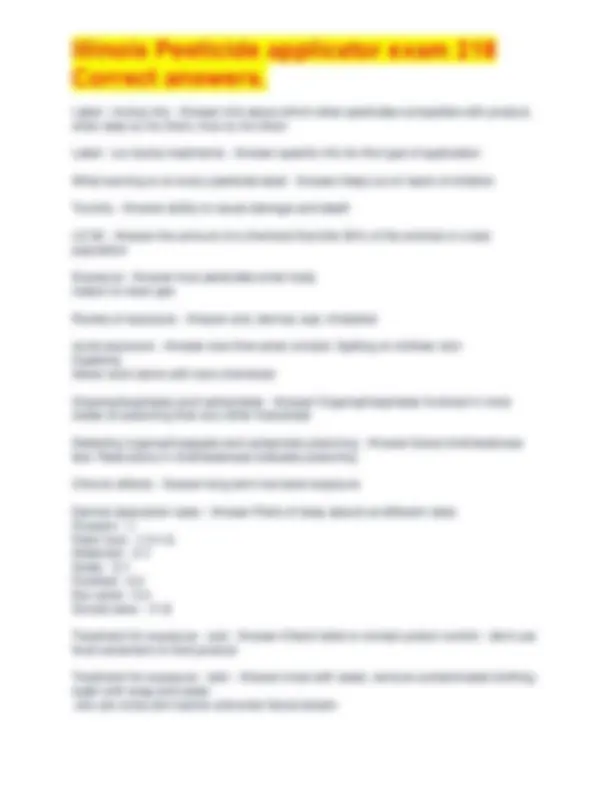
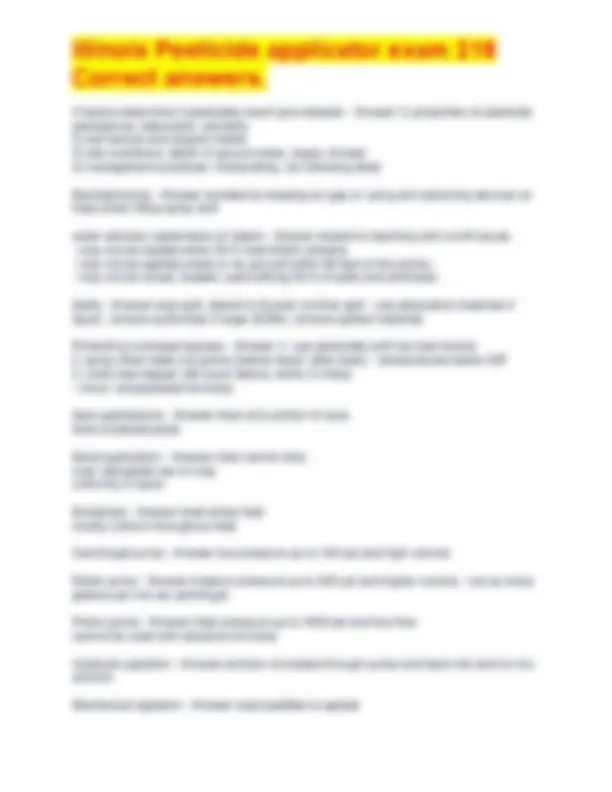
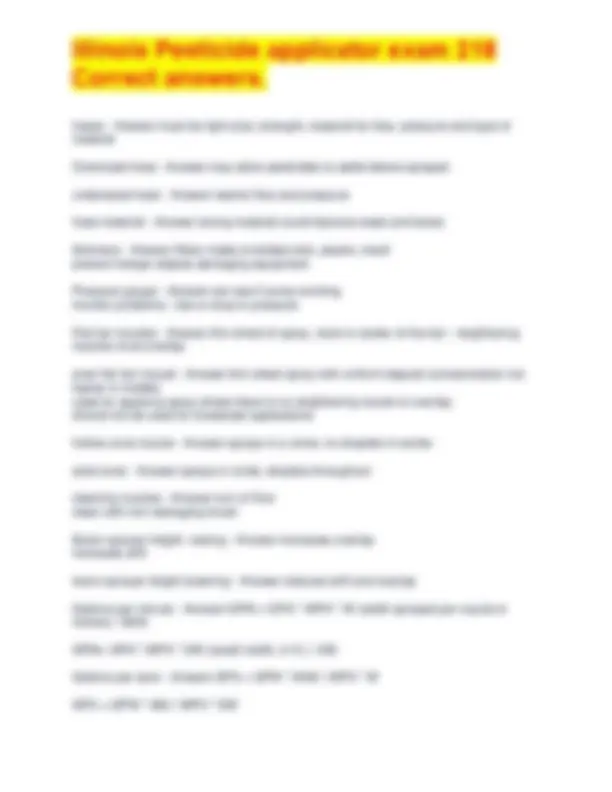
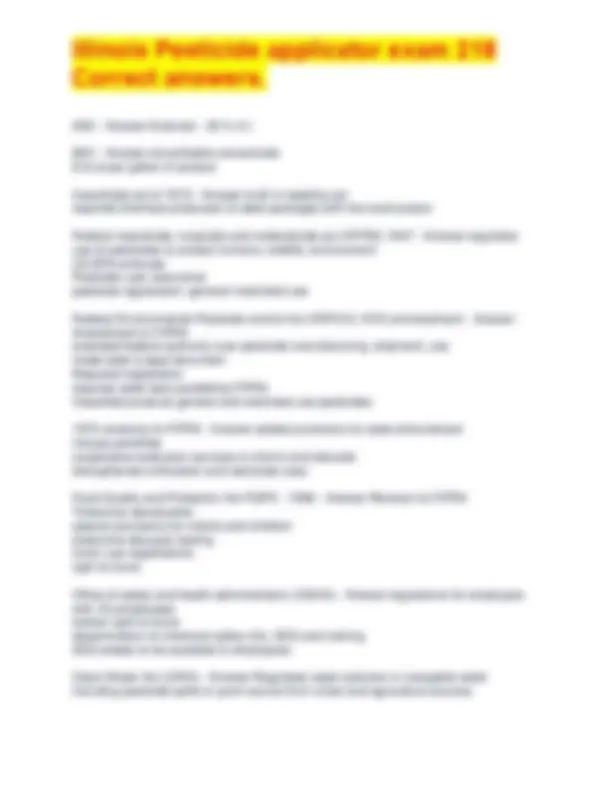
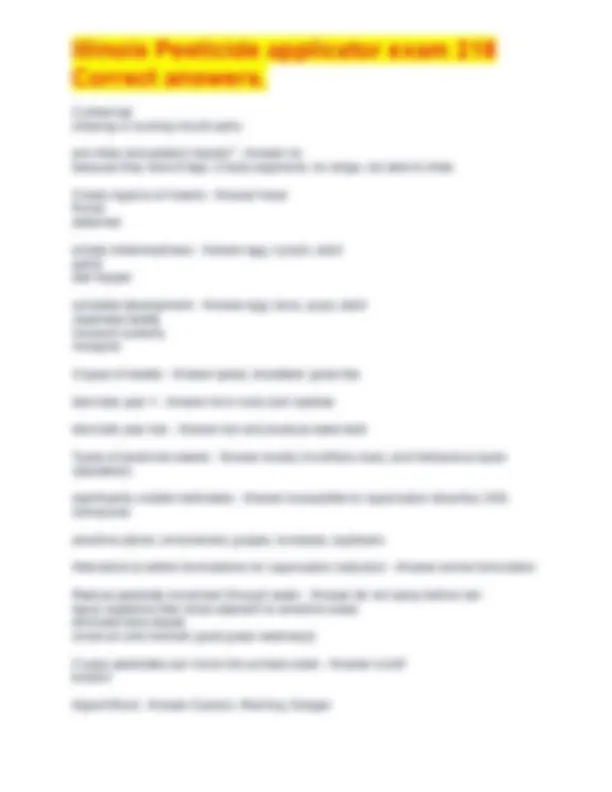
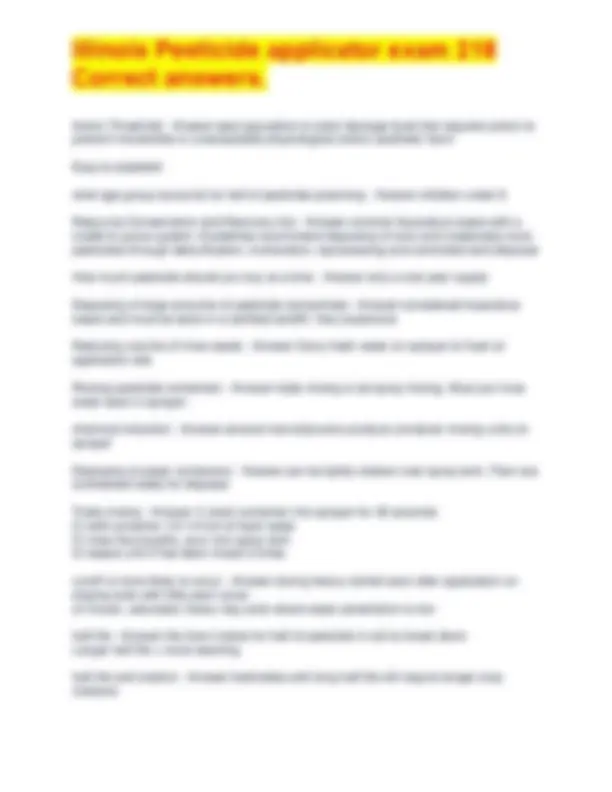
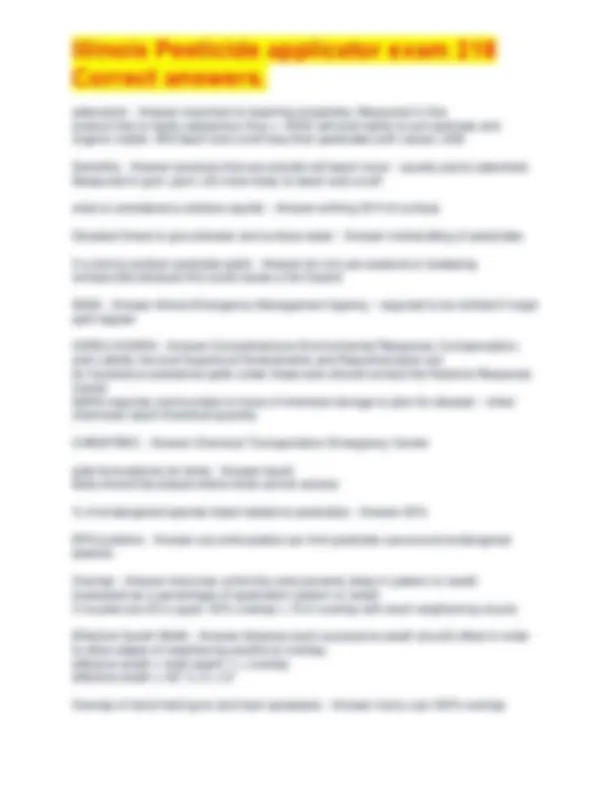


Study with the several resources on Docsity

Earn points by helping other students or get them with a premium plan


Prepare for your exams
Study with the several resources on Docsity

Earn points to download
Earn points by helping other students or get them with a premium plan
Community
Ask the community for help and clear up your study doubts
Discover the best universities in your country according to Docsity users
Free resources
Download our free guides on studying techniques, anxiety management strategies, and thesis advice from Docsity tutors
A comprehensive overview of the regulations and requirements surrounding the use of pesticides in the united states. It covers topics such as the licensing and certification of pesticide applicators, the labeling and classification of pesticides, the environmental and safety considerations when applying pesticides, and the various federal and state agencies involved in pesticide regulation. The document also delves into the specific responsibilities and record-keeping requirements for commercial and private pesticide applicators, as well as the worker protection standards that employers must adhere to. Overall, this document serves as a valuable resource for anyone involved in the application of pesticides, whether in an agricultural, commercial, or residential setting.
Typology: Exams
1 / 17

This page cannot be seen from the preview
Don't miss anything!










What is a pesticide - Answer-a substance used for destroying insects or other organisms harmful to cultivated plants or to animals. Pesticides are made up of - Answer-Active and inert ingredients AI - Answer-Active ingredient - chemical effective against pest Inert ingredients - Answer-don't harm pest but make the AI more effective Herbicide formulation - Answer-may be ready to use or may require dilution with carrier (oil or liquid) 60WDG - Answer-60% AI water-dispersible granule 4EC - Answer-4 lbs ai per gallon of emulsifiable concentrate SP - Answer-Soluable powder - dry formulation. Mixed with water. Dissolve readily and form true solution. WP, P - Answer-Wettable Powder - dry formulation. Finely ground powder. Forms suspension not true solution. Abrasive, requires agitation, inhalation risk DF, WDG - Answer-Dry flowables or water dispersible granules - dry formulation. Similar to WP except AI is in granule instead of powder form suspension. Less dust than WP G - Answer-Granules - dry formulation. AI coated with clay, newspaper Applied directly, no mixing Low hazzard to applicators P, PS - Answer-Pellets - dry formulation. Same as granules but larger D - Answer-Dusts - dry formulations. Low percentage of AI on very fine carrier (talk, chalk, clay) Most ready to use (no mixing) Inhilation hazard Drift hazzard (uncommon use)
EC - Answer-Emulsifiable concentrate - wet formulation. AI mixed with 1+ solvents and emulsifier that allows mixing with water Easily absorbed through skin (dermal hazzard) ME - Answer-Microencapsulated - wet formulation AI is surrounded by plastic coating suspended in liquid Time- release product Bees catty it back to hive and can poison colony S - Answer-Solutions - wet formulation Form true solution when mixed Will not settle or separate ULV - Answer-Ultra-low volume concentration - wet formulation Have high % ai with a solvent (usually oil) Low application rate per acre Fumigants - Answer-Produce gas, vapor, fumes, etc. Special licencing required Highly toxic Restricted use pesticides - Answer-Only purchased by certified applicators or persons under their supervision Records of applications must be maintained for 2 years Adjuvant - Answer-Chemical modifies physical properties, enhances performance or both of pesticides Includes spray modifiers Activatior adjuvants - Answer-Water spreader (surfactants), Sticker (oils, laytex), humectant,penetrator utility adjuvants - Answer-defoamer, water conditioner (acids) Drift reduction additives - Answer-thickening agents increase droplet size Droplets must be over 200 microns Sticker - Answer-increase adherence of chemical to surface Surfactant, Spreaders - Answer-Spread spray mix more thoroughly Decreases surface tension of water Penetrants - Answer-helps pass through outer surface of plants - through waxy coating on leaves (cuticle)
Contact pesticide - Answer-control by direct contact with pest kill annuals if all growing parts are above ground Information on a label - Answer-Impact on wildlife, PPE, Re- entry interval Before purchasing read label - Answer-label is legal document, general use pesticide is not given classification Label - Trade name - Answer-this specific formulation label - chemical name - Answer-shows what active ingredients in formulation label - AI concentration - Answer-important for determining rates label - EPA registration number - Answer-unique to every formulation label - PPE requirements - Answer-must follow these label - hazard statement - Answer-volunteers can only apply herbicides labeled as caution label - manufacturer contact info - Answer-Incase of emergency label - general info - Answer-basic info on how pesticide works and how long it takes to see effects, what conditions to treat Label - cautionary statements - Answer-avoid unintended injury to non-targets Label - spray solution chart - Answer-determine amount needed for different solution strengths Label - control recommendations - Answer-Recommendations for control of different weeds Label - species specific control recommendations chart - Answer-Control recommendations for specific species Label - wetland/ aquatic info - Answer-if applying near water need to use product labeled for use in those areas. Specific info about this type of application label - sites specific control recommendations chart - Answer-specific control recommendations for certain sites (forestry, utility rights of way)
Label - mixing info - Answer-Info about which other pesticides compatible with product, what rates to mix them, how to mix them Label - cut stump treatments - Answer-specific info for this type of application What warning is on every pesticide label - Answer-Keep out of reach of children Toxicity - Answer-ability to cause damage and death LD 50 - Answer-the amount of a chemical that kills 50% of the animals in a test population Exposure - Answer-how pesticides enter body reason to wear ppe Routes of exposure - Answer-oral, dermal, eye, inhalation acute exposure - Answer-one-time sever contact. Spilling on clothes/ skin Ingesting Never work alone with toxic chemicals Organophosphates and carbamates - Answer-Organophosphates involved in more cases of poisoning than any other insecticide Detecting organophospgate and carbamate poisoning - Answer-blood cholinesterase test. Reductions in cholinesterase indicates poisoning Chronic effects - Answer-long term low-level exposure Dermal absorption rates - Answer-Parts of body absorb at different rates Forearm - 1 Palm/ foot - 1.3-1. Abdomen - 2. Scalp - 3. Forehad - 4. Ear canal - 5. Scrotal area - 11. Treatment for exposure - oral - Answer-Check label or contact poison control - dont use food containers to hold product Treatment for exposure - skin - Answer-rinse with water, remove contaminated clothing, wash with soap and water oils can cross skin barrier and enter blood stream
triple rinse, still have residue Tank/ backpack rinsing - Answer-some oil formulations (24D) may leave residues that can cause harm to plants Use household ammonia to rinse oily residue Particle drift - Answer-spray particles move usually by wind Prevent drift - Answer-Dont spray when: winds over 10MPH, winds shifty, winds blowing towards sensitive areas, during periods of calm/ inversions Vapor drift - Answer-formed after application carried out of target area (volitization) can occur up to several days after some products if used in hot weather Factors increase drift - Answer-droplet size under 200 microns wind/ air currents sprayer too far from plant high temps with high evaporation Movement of pesticides by water - Answer-leaching, seepage, application prior to rainfall runoff into surface water reducing movement of pesticides by water - Answer-nozzle pressure, droplet size, spray height Run-in - Answer-when pesticide moves directly from soil surface to groundwater below Leaching - Answer-movement of pesticide downward in soil profile with percolating water can contaminate groundwater Pesticides degradation in ground water - Answer-is much slower in ground water because low oxygen and light Leaching more likely if - Answer-pesticide over-applied sandy soil soil is bare Pesticide properties applied before heavy rain/ irrigation spills
4 factors determine if pesticides reach groundwater - Answer-1) properties of pesticide: persistence, adsorption, solubility
20G - Answer-Granular - 20 % A.I 8EC - Answer-emulcifiable concentrate 8 lb ai per gallon of product Insecticide act of 1910 - Answer-truth in labeling act required chemical producers to label packages with the word poison Federal insecticide, fungicide and rodensticide act (FIFRA) 1947 - Answer-regulates use of pesticides to protect humans, wildlife, environment US EPA enforces Pesticide user assurance pesticide registration: general/ restricted use Federal Environmental Pesticide control Act (FEPCA) 1972 ammendment - Answer- Amendment to FIFRA extended federal authority over pesticide manufacturing, shipment, use made label a legal document Required registration requires state laws paralleling FIFRA Classified products general and restricted use pesticides 1975 revisions fo FIFRA - Answer-added provisions for state enforcement misuse penalties cooperative extension services to inform and educate strengthened cirtification and restricted uses Food Quality and Protection Act FQPA - 1996 - Answer-Revision to FIFRA Tolerance reevaluation special provisions for infants and children endocrine disruptor testing minor use registrations right to know Office of safety and health administration (OSHA) - Answer-regulations for employers with 10+employees worker right to know dissemination of chemical safety info, SDS and training SDS sheets to be available to employees Clean Water Act (CWA) - Answer-Regulates water pollution in navigable water including pesticide spills or point source from urban and agriculture sources
Illinois Department of Public Health (IDPH) - Answer-administers illinois structural pest control act Protect public health by setting standards to control pests inside or under structures licensing restricted pesticide use
2 antennae chewing or sucking mouth parts are mites and spiders insects? - Answer-no because they have 8 legs, 2 body segments, no wings, not able to chew 3 body regions of insects - Answer-head thorax abdomen simple metamorphosis - Answer-egg, nymph, adult aphid leaf hopper complete development - Answer-egg, larva, pupa, adult Japanese beetle monarch butterfly mosquito 3 types of weeds - Answer-grass, broadleaf, grass like biennials year 1 - Answer-form roots and rosettes biennials year two - Answer-bot and produce seed stalk Types of perennial weeds - Answer-woody (multiflora rose), and herbacious types (dandelion) significantly volatile herbicides - Answer-susceptible to vaporization dicamba, 24D, clomazone sensitive plants: ornamentals, grapes, tomatoes, soybeans Alternative to esther formulations for vaporization reduction - Answer-amine formulation Reduce pesticide movement through water - Answer-do not spray before rain leave vegitative filter strips adjacent to sensitive areas eliminate bare slopes construct and maintain good grass waterways 2 ways pesticides can move into surface water - Answer-runoff erosion Signal Word - Answer-Caution, Warning, Danger
Action Threshold - Answer-pest population or plant damage level that requires action to prevent irreversible or unacceptable physiological and/or aesthetic harm Easy to establish what age group accounts for half of pesticide poisoning - Answer-children under 6 Resource Conservation and Recovery Act - Answer-controls hazardous waste with a cradle to grave system. Guidelines recommend disposing of toxic and moderately toxic pesticides through detoxification, incineration, reprocessing and controlled land disposal How much pesticide should you buy at a time - Answer-only a one-year supply Disposing of large amounts of pesticide concentrate - Answer-considered hazardous waste and must be done in a certified landfill. Very expensive Reducing volume of rinse waste - Answer-Carry fresh water on sprayer to flush at application site Rinsing pesticide containers - Answer-triple rinsing or jet spray rinsing. Must put rinse water back in sprayer. chemical induction - Answer-several manufacturers produce container-rinsing units on sprayer Disposing of paper containers - Answer-can be lightly shaken over spray tank. Then are considered ready for disposal Triple rinsing - Answer-1) drain container into sprayer for 30 seconds
annual application limit - Answer-some pesticides have a max application of ai per area per year. e.g. atrazine Amount of spray - Answer-depends on pressure and orifice size. Nozzles have charts that tell you gallons per min most efficient way to get more spray - Answer-replace with larger nozzle rather than increasing pressure. It takes a 4* increase in pressure to get double the flow - could result in drift Measure GPM - Answer-Spray water through equipment at pressure you intend to use and measure output of each nozzle with flow meter or by collecting volume Measure MPH - Answer-ft * 60 / seconds * 88 Callibrating spray guns - Answer-spray 1000 feet with clean water at rate you would apply - time yourself run the sprayer for the same amount of time into a bottle and measure amount of liquid Components of granular application equipment - Answer-hopper, meter, agitator,distributor callibrating granular spreaders - Answer-collect output while spreading on 100 or 1000 ft then weigh them 1988 ammendment FIFRA - Answer-required re-registration of many older products Is illinois law stricter than federal law for applicators - Answer-yes CAA - Answer-Clean Air Act regulates dust and fumes from ag chemical plants CWA - Answer-Clean Water Act pollution in navigable waters including pesticide spills RCRA - Answer-Resource Conservation and Recovery Act regulates management of solid and hazardous waste Illinois department of ag - Answer-responsible for registration, purchase, use in outdoor environments or in production of ag commodities Illinois department of public health - Answer-enforcing laws regulate pesticide use for structural pest control illinois epa - Answer-protecting air and water quality. remediating contaminations
Illinois pesticide act - Answer-regulates labeling, distribution, use pesticides IDA enforces. Penalties in 24 or 24.1 fines up to 10000 structural pest control act - Answer-protect public health by creating regulations for applications in structures enforced by illinois department of public health Illinois pollution control board rule 302.210 - Answer-USEPA applications of pesticides to auquatic areas. Requires applicator to be licensed and a permit if application is happening to public/ food processing waterway Interagency committee on pesticides - Answer-review status of sale and use, review and approve all peesticide programs directed by government, consider problems arising from pesticides, recommend pesticide legislation to government NPDES permits for pesticide application - Answer-national pollution discharge elimination system Need permit for certain applications near water edge: mosquito/ insecct, weed and algae, animal, forested areas under clean water act Generators of hazardous waste - Answer-required to register if more than 100 kg of waste per mount, more than 1 kg of acutely hazardous waste, more than 100 kg of contaminated soil, waste from clean up or spill of acutely hazerdous WPS reqirements - what employers must provide - Answer-central posting with number of emergency, facts about each pesticide pesticide safety training decontamination sites emergency assistance WPS - what employers must do for employees - Answer-notify them aboul applications protect during applications observe REI WIPS what employers must do for handlers - Answer-monitor handkes applying pesticides with skull and crossbones give specific info of pesticide provide equipment safety info provide and maintain PPE